The sound of sirens and flashing lights woke Claretian Father John Molyneux, pastor of the Mission San Gabriel parish, around 4:30 a.m. on July 11, when firefighters arrived to tell priests to evacuate the rectory. The historic 249-year-old California church near Los Angeles was ablaze, with flames and smoke erupting from the wooden roof.
“The first firefighter on the scene, a captain, told me he was married in this church,” says Molyneux, who is also the former editor-in-chief of U.S. Catholic.
Hearing the news, parishioner Carrie Evanilla hurried toward the historic mission that has been her family’s spiritual home for four generations, a few blocks from her home. She thought of her parents buried in the mission cemetery, her wedding at the mission, and her siblings and children baptized in the church and educated at the parish’s schools.
“As I walked toward the church, I saw water gushing down the sidewalks toward my house, and in the water are all these pieces of burnt wood, and I realized this was the mission’s roof,” says Evanilla.
Within hours, the sidewalks in front of the church were filled with parishioners and gawkers, all staring at the smoking ruins of a structure that held a great emotional connection to generations of San Gabriel residents.
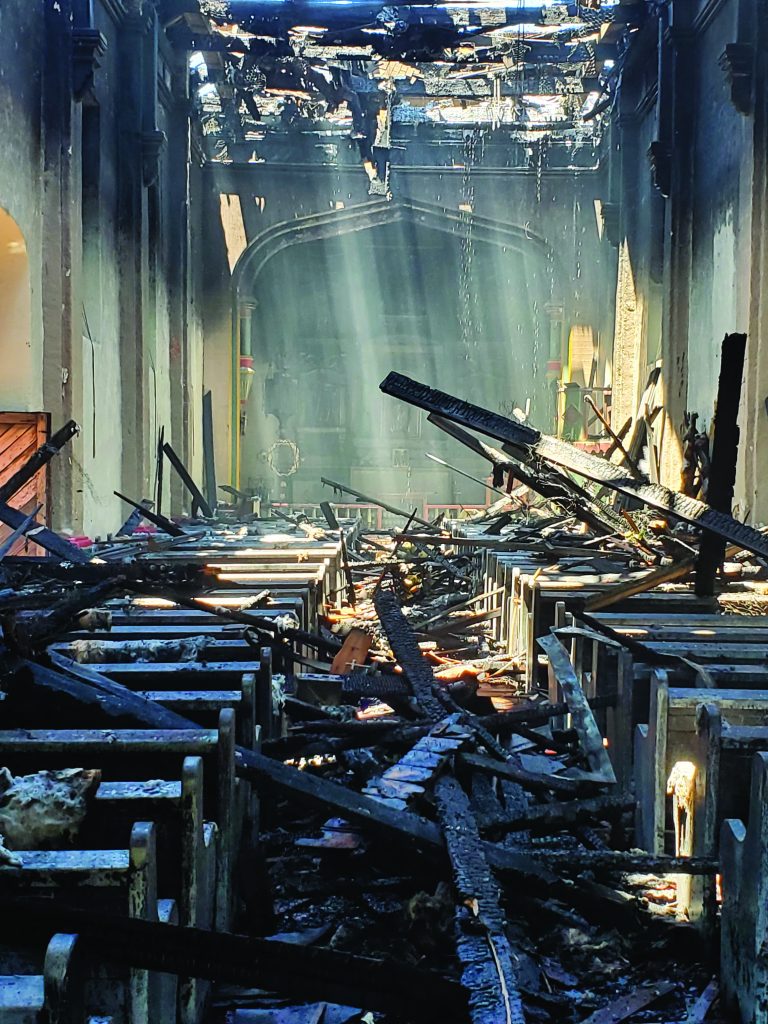
Photo: Terri Valadez.
“I was crying the whole time,” Evanilla says. “We all just stood around, devastated, not knowing what the damage was.”
The roof of the 150-foot-long adobe and lime structure had caught fire, dropping charred beams into the sanctuary and exposing the sky above. But above the altar, an inner roof with coffered ceilings protected the massive hand-carved Mexican retablo and statues behind the altar. These works sustained some soot damage but are restorable, says Terri Huerta, the parish’s director of development and communications. Meanwhile, the larger, modern, air-conditioned chapel, built in the 1940s, was undamaged. The rectory and mission museum were also spared by the fire.
The church was in the middle of a renovation, so the parish had moved religious paintings imported from Spain in the 18th century, a hammered copper baptismal font, and other artwork to storage.
Crews had just replastered and painted the five-foot-thick lime walls and replaced the lovingly restored 100-year-old pews in the sanctuary only a few days earlier in preparation for the parish’s first pandemic-era socially distant Mass. “After the workers were gone Friday and the pews were installed, it looked beautiful. We were so excited about opening for services on July 18, and we were going to kick it off with a wedding,” Huerta says.
Now the community is trying to regroup and figure out how to stay on track for a long-planned 250th anniversary scheduled for September 2021.
“As I walked toward the church, I saw water gushing down the sidewalks toward my house, and in the water are all these pieces of burnt wood, and I realized this was the mission’s roof,” says Evanilla.
“The community is in a mourning process,” Molyneux says. “I consider it like the circumstances under which I would preach a funeral. People have so many mixed emotions; they are confused, angry, and sad. This parish has been such a part of their life. But we are a resurrection people, and we have come out of this much stronger. The fire has brought us together.”
Cornerstone of the community
Mission San Gabriel has influenced the history of Los Angeles and southern California. A river, mountain range, valley, and city all bear its name. Mission San Gabriel is also considered the “godmother” of Our Lady Queen of Los Angeles Church, also called “La Placita,” the oldest church in Los Angeles.
School children visit the mission and mission museum yearly as part of the state’s history curriculum. The church’s historic interior is a popular wedding location, and the parish’s multicultural Labor Day Fiesta (canceled this year due to the pandemic) is a regional event.
Los Angeles Archbishop José H. Gomez delivered a homily on the site calling the fire “terribly sad.”
“Thanks be to God, nobody was hurt. . . . Mission San Gabriel is the historic cornerstone and the spiritual heart of Los Angeles and the Catholic community here,” Gomez said in a letter to the faithful after the fire. “To this day, the parish at San Gabriel Mission continues to be a shining expression of the beautiful diversity that God intends for his human family.”
Gomez also asked for prayers for the mission parishioners, saying, “May they know the comfort and consolation of our loving Father and the solidarity and care of the entire family of God here in the Archdiocese of Los Angeles.”
“This fire changes nothing,” the archbishop said in a Mass the day after the fire. “Mission San Gabriel will always be the spiritual heart of the church in Los Angeles, the place from which the gospel still goes forth.”
The long arm of history
The current mission church was built in 1794, the fourth of 21 missions constructed in the period by Franciscan friars under the leadership of St. Junípero Serra. St. Junípero, who was canonized by Pope Francis during a 2015 visit to the United States, has been controversial because of the way California’s Native Americans were mistreated and abused during the Mission Period between 1769 and 1833.
But bishops in the California Catholic Conference say Serra was a “tireless advocate for the rights of Native Americans.”
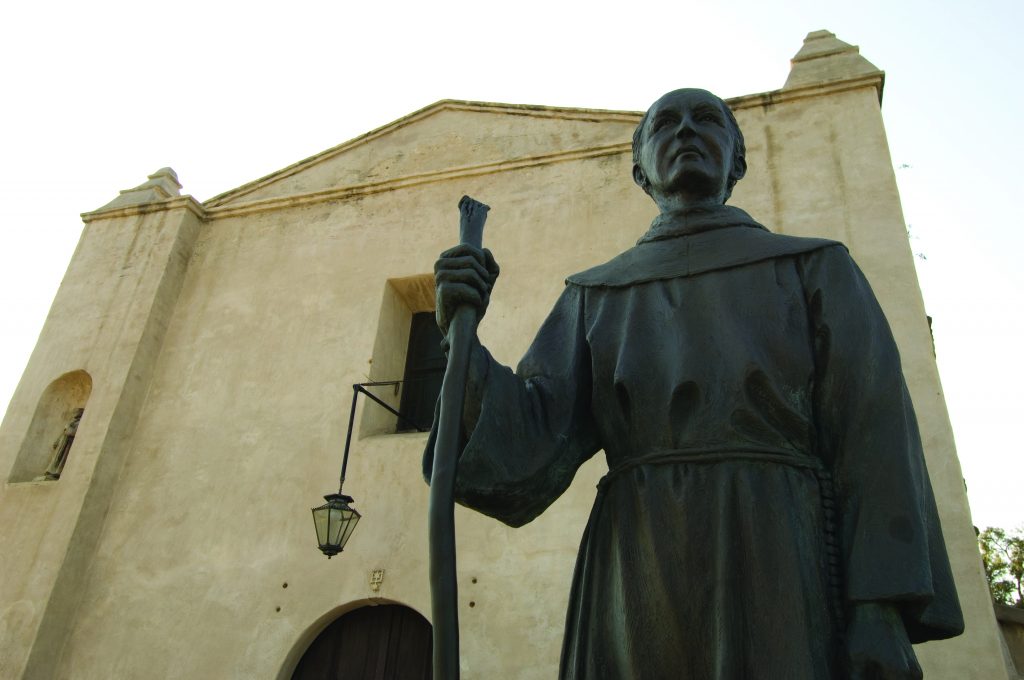
For almost a decade, Mission San Gabriel and the Archdiocese of Los Angeles have worked with Native Americans to address the complicated history of the European colonization of southern California and its effects on the indigenous people of the area.
“We respect the pain felt by our native brothers and sisters and their anger at the historical abuses committed against their ancestors, both during the Mission Period and especially afterward,” a statement from the bishops said before the fire, earlier in July. “But we need to again remind our fellow Californians, St. Junípero Serra had nothing to do with these abuses. The true historical record is clear on this point. St. Junípero loved and bravely defended the native peoples, even writing a bill of rights to protect them from the ambitions of the Spanish colonizers.”
In its early days, Mission San Gabriel stood witness to the mistreatment of Native Americans. More than 12,000 Tongva Indians were baptized by Franciscan priests as “neophytes,” the contemporary term for newly converted non-Christian peoples. But the newly baptized were held on the Mission San Gabriel grounds and not allowed to return to their villages once they had become Christian.
Under the watchful eyes of Spanish soldiers, in the mission’s heyday about 5,000 Tongva natives worked under threats of beatings, providing an enslaved workforce for a massive agricultural and manufacturing center that helped support settlers, friars, and soldiers across southern California.
During the six decades when the mission was under Franciscan control, the compound included kitchens, a vineyard, and barns where up to 120,000 head of cattle and other livestock were raised, historical accounts say. The Franciscans ran factories where Tongva laborers produced soap, candles, and shoes as well as ran a tannery, brick kiln, and mills for looming, saw cutting, and producing flour. The mission also had a gunpowder factory, a small hospital, and a school.
During the Mission Period, disease, hardship, and hunger decimated California’s native population, which dropped from 72,000 people to fewer than 18,000. Around 6,000 neophytes are buried in the Campo Santo cemetery beside the church.
When supply ships and church payments were absent for a few years and a flood and earthquake hit the area in 1812, about 400 Indian women and children on the mission died of starvation and disease, says Julia Bogany, a Tongva elder and cultural consultant.
“The truth has to be told first in order for my people to heal. When I heard about the fire, it felt like my friend had lost their house, because we have that relationship.”
The Mexican War of Independence between 1810 and 1821 ended Spanish rule, and the mission system in California was secularized by the Mexican government in 1833. Mission lands and holdings were turned over to ranchers and settlers. By then only about 250 Tongva Indians were laboring on the mission.
The native people fared much worse in the 1830s and through the 1850’s gold rush, says Bogany. “But we made it,” she says. “We’re survivors, we’re resilient people. It wasn’t a pretty picture, but I don’t think all my ancestors died angry.”
For the past seven years, Mission San Gabriel has worked with members of the San Gabriel Band of Mission Indians, also called the Gabrielinos or Gabrieleños, to provide a clearer picture of the complicated history of the mission system.
Native American activities have included docent tours and story sessions as well as ceremonies in tribal regalia, says Bogany, who is working alongside other tribal members to plan the mission’s 250th anniversary celebration.
“We respect each other, and members of the church were willing to hear the truth and accept it,” Bogany says. “The truth has to be told first in order for my people to heal. When I heard about the fire, it felt like my friend had lost their house, because we have that relationship.”
Evolution and change
After the Franciscans left, as history moved forward and California became part of the United States, the mission continued to evolve and change.
During the U.S. Civil War, President Abraham Lincoln regranted Mission San Gabriel and its grounds to the Catholic church.
Then in 1907 the mission was repurposed by Bishop Thomas J. Conaty to serve Spanish-speaking Catholics in the Los Angeles area. Antichurch repression by the Mexican government had led to a shortage of priests, and few migrants had regular access to the sacraments.
Priests from the Claretian order, founded in Spain in 1849 by St. Anthony Mary Claret, were invited to exclusively serve Mexican farmworkers and other Spanish-speaking parishioners.
“The Claretians have a history, starting in San Antonio, Texas, of serving as a bridge to the Mexican community,” says Malachy McCarthy, a Chicago-based archivist for the Claretian order, which publishes U.S. Catholic. “The church was a way station to Americanization. It allowed the community to be proud and maintain their cultural heritage and yet gradually move into assimilation and into American English-speaking Catholic life.”
Continuing a dialogue
The Mission San Gabriel blaze took place just as a second round of COVID-19 lockdowns were reintroduced in California and as protests and unrest were taking place across the country in reaction to the police-involved death of George Floyd in Minneapolis. Several of this summer’s California protests, including in Los Angeles and San Francisco, involved the toppling of statues of St. Junípero Serra.
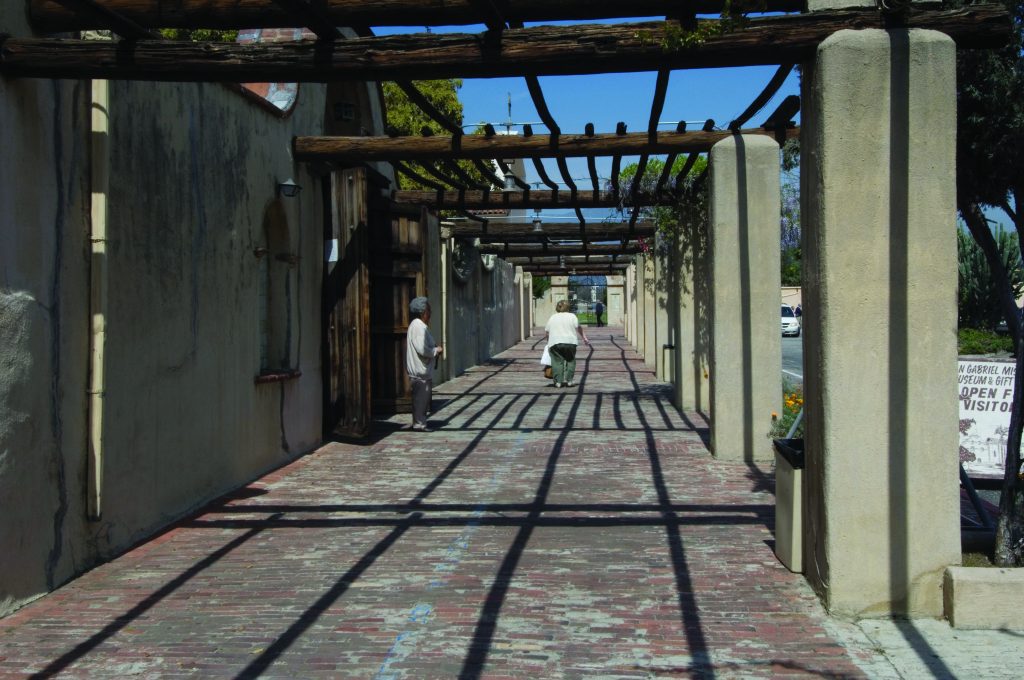
Photo: David Snyder for the St. Jude League
Shortly before the fire, Molyneux relocated the mission’s bronze statue of St. Junípero, installed in the 1980s, from outside the mission to another nonpublic area.
“Whereas the California Catholic Conference of Bishops reminds us that the historical truth is that St. Serra repeatedly pressed the Spanish authorities for better treatment of the Native American community, we recognize and understand that for some he has become a symbol of the dehumanization of the Native American community,” Molyneux wrote in a message to parishioners. “We at Mission San Gabriel are committed to continuing dialogue with our Native American representatives in order to achieve a peaceful and just partnership.”
Some parishioners worried that the fire may have been intentionally set as a part of a protest of the history of the mission system, Molyneux says. But he stresses that investigators have not indicated that arson was involved.
The day of the fire, one of the first people to arrive on the scene was Anthony Morales, chief of the San Gabriel Band of Mission Indians and a Roman Catholic who grew up in the parish.
“It was just devastating for me. It was heartbreaking to see the roof and the smoke,” Morales says. “I choked up. The mission for us is the center of our tribe. It’s also a sacred site, [because of the] 6,000 or more of our ancestors buried throughout the whole church property. I envisioned my ancestors who built the church and thought about what was happening here.”
Morales credits his parents’ generation with opening up a dialogue with the church to look at the history of the Gabrieleños and the missions. “Because of our parents, we all feel welcome. We’re Catholic and we go to Mass here. We’ve done our sacraments here,” he says. “The treatment of our people, the forced slavery, the genocide, it wasn’t a good chapter of history for our people. We cannot change that. But then again we shouldn’t be hiding it. It should be out there in the open.”
The relationship between the Gabrieleños and the church is another example of a resurrection people, Morales says. “At the present it’s a time of healing. The church is coming around and working with us to try to get that healing going. We’re teaching each other.”
As part of the 250th-anniversary jubilee Morales has contributed to plans to create a memorial garden to honor the Gabrieleños. “Some people would say if the Catholic Church did all this, why are you so close to them?” Morales says. “But we are the direct descendants of the people who built that building. If we ignored them, my ancestors would have died in vain.”
Into the future
Today, demographics in the city of San Gabriel have changed. Around 65 percent of the population is now Asian. As the city gentrified from a rural area to a bustling suburb of Los Angeles, many of the Spanish-speaking families moved away. But they still feel loyalty to the church where generations of family members attended its schools and were baptized, married, and buried.
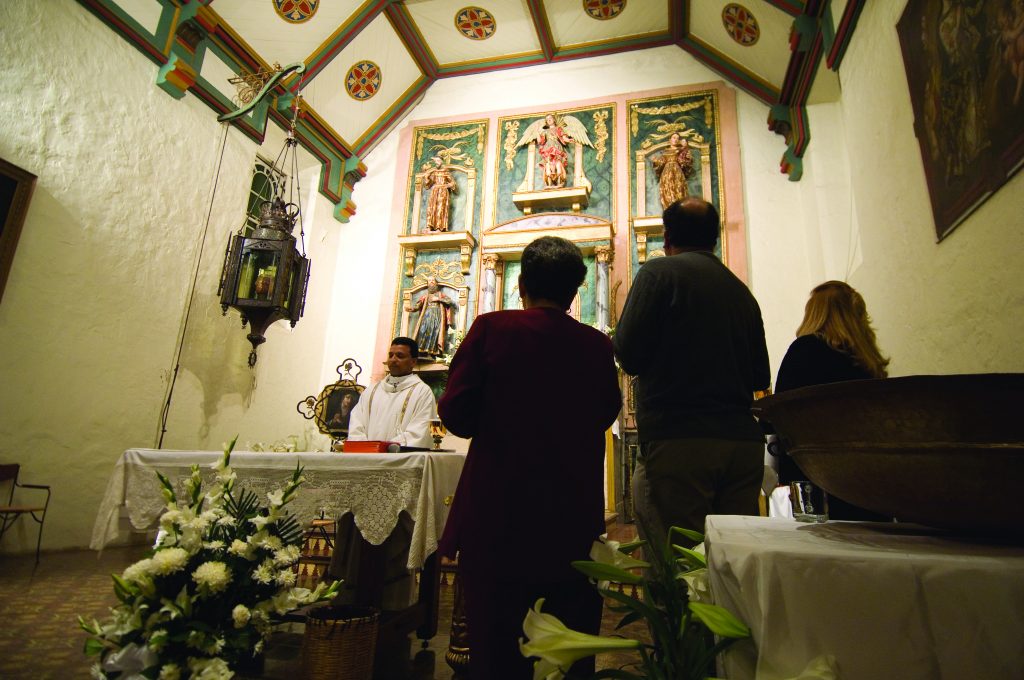
Photo: David Snyder for the St. Jude League
When news of the fire hit social media, donations began to flood in from a diaspora of former parishioners all over the country, says development director Terri Huerta. “Even in the face of all of this, they are very hopeful,” she says. “This is their church, and it holds their legacies and memories for family members. Everyone is committed to help us rebuild. Even people who are not Catholic have stepped forward to ask, ‘How can we help preserve this beautiful place we are so connected to?’ ”
The Vietnamese community at the church has been especially generous, says Father Gerald Kumar, who preaches in Vietnamese at two Masses per week.
Vietnamese Catholics began to arrive in Los Angeles in 1975 after the end of the Vietnam War. They petitioned the archdiocese in 1976 to give them a spiritual home, says Bryan-Huy Nguyen, chairman of the Vietnamese community at Mission San Gabriel.
Members of the San Gabriel parish sponsored Vietnamese refugee families in the early days as they settled into life in California, a resurrection people leaving behind their war-destroyed homes and cities.
Today, Vietnamese parishioners at the mission are active volunteers in the choir, youth groups, and parish festivals, says Nguyen. The community tries to keep the culture alive for young people with mid-autumn and Lunar New Year festivals including special mooncakes and dragon dances. About 600 Vietnamese Catholics from the region attend these events.
Vietnamese Americans in the parish, who will celebrate their 45th year in 2021, have provided a “bridge to Americanization” for Kumar, a Claretian priest who grew up in India but who worked in Vietnam for 11 years providing formation for future priests.
In Vietnam, Kumar says, he observed how Catholics love the church. “The house of God is
like their family. The families are very poor, but the house of God, their church, is very rich and luxurious. They want it to look nice.” Shortly after the fire, Kumar says, Vietnamese parish families were pressing donations into his hands.
“The day of the fire, a man came by and told me that adobe gets stronger under intense heat,” he says. “And our church is getting stronger. That is a great image to pray with.”
Advertisement
“To us, this is a chance to contribute to renew our lovely old mission church,” says Nguyen. “Every family has tried to contribute something, depending on their ability to pay.”
Meanwhile, the pandemic and now the fire are challenging Father Molyneux’s confidence. “For the first time I sometimes don’t know what to do,” Molyneux says.
But he is grateful to parishioners who were joyful to finally receive the Eucharist at an outdoor Mass for the first time after weeks of online-only services. Some had tears in their eyes as they received communion, Molyneux says.
“They really love the church. This crisis has brought us together as a resurrection people,” Molyneux says.
Parishioner Carrie Evanilla says the fire created a unity in the parish during the pandemic. “God brings hardships to us to learn something or to become closer to someone,” she says. “We realized that we can take for granted what the church has to offer. The fire has opened our eyes to appreciate what we do have, the good in the church, the sense of community.”
Molyneux agrees. “The day of the fire, a man came by and told me that adobe gets stronger under intense heat,” he says. “And our church is getting stronger. That is a great image to pray with.”
To support Mission San Gabriel’s restoration efforts, visit shrineofstjude.org/support-san-gabriel-mission
This article also appears in the October issue of U.S. Catholic (Vol. 85, No. 10, pages 10-15). Click here to subscribe to the magazine.
Image: Courtesy of Mission San Gabriel


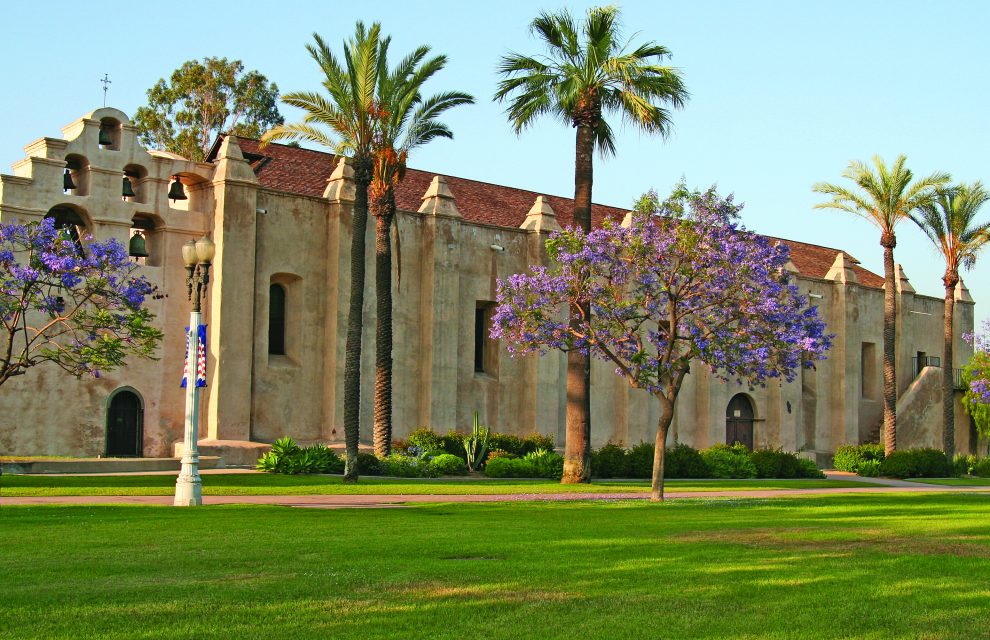



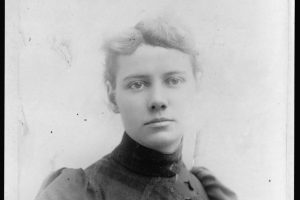







Add comment